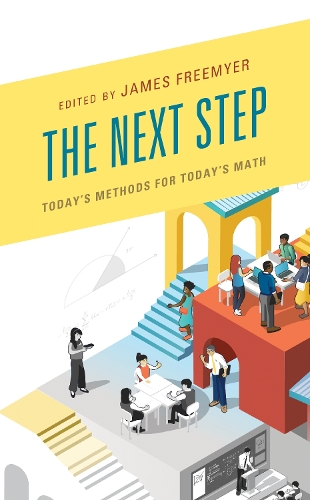
The Next Step: Today's Methods for Today's Math
(Paperback)
Publishing Details
The Next Step: Today's Methods for Today's Math
By (Author) James Freemyer
Bloomsbury Publishing PLC
Rowman & Littlefield Publishers
24th October 2019
United States
Classifications
Professional and Scholarly
Non Fiction
Educational: Mathematics and numeracy
Educational strategies and policy
Teacher training
510.71
Physical Properties
Paperback
190
Width 152mm, Height 221mm, Spine 12mm
313g
Description
This book is written on the behalf of mathematics teachers who have been asked to teach more conceptually while simultaneously motivating more students of all ability levels to willingly embrace further upper level mathematics content and courses. This is a BIG ASK! Math teachers are being expected to overhaul their current teaching approach. Can teachers be expected to embrace this crusade alone, isolated in a classroom
Principals are charged with leading the way. They must provide the opportunities and resources necessary for effective teacher collaboration. After reading this book, a principal will comprehend the enormity of task each mathematics teachers faces and learn what must be done to help. School leaders will be able to design a growth plan based on a plethora of collaborative approaches. Mathematics teachers will experience the assistance they have desperately needed.
Reviews
Three decades have passed since the National Council of Teachers of Mathematics released its initial standards for teaching mathematics. Yet the controversy stemming from these recommendations continues, so teachers and schools are still debating how to effectively meet the needs of their mathematics students. Freemyer (Indiana Wesleyan Univ.) here builds on the assumption that change from the traditional approach is strongly needed, and that K-12 mathematics education must adopt a student-centered focus based on conceptual teaching, collaborative learning, and meaningfully challenging investigations. This is not a how-to book full of classroom lesson plans, but rather a guideline for what school leadership must do to initialize and support such change. Including eleven chapters, five of them authored by the editor, this work provides advice to principals and mathematics curriculum leaders on the steps needed to reform the mathematics teaching in their schools. All contributors are realistic about the existing spectrum of teacher attitudes and beliefs, which complicates the incorporation of such changes. They repeatedly emphasize that to change effectively requires a commitment of time and resources so that teaching staff can collaborate with one another, share materials, and discuss techniques. Otherwise, as argued here, change is unlikely ever to occur. Summing Up: Recommended. Faculty and professionals. * Choice Reviews *
As a career Mathematics teacher educator, it is wonderful and rare to see the challenges facing school mathematics teachers in the early 21st Century articulated with such clarity, insight and empathy. The significance of this work is heightened because it is anchored in research, is tempered by many years of professional practice in mathematics teaching and education, and is very positive and realistic about what can be achieved in mathematics education for all students. The authors recognize the enormity of the task that mathematics teachers face in their professional lives and the personal effort needed to transform their practice in pursuit of better outcomes for all their students. This insight applies across the globe where reforms are embraced.
All agree that change is necessary and there is a remarkable international consensus on the nature of this change, namely, a move to a more realistic, problem-based conceptual approach to school mathematics that facilitates better outcomes for all students regardless of ability. Achieving the necessary transformation of teachers own practice and student learning is an enormous task and demands a sustained concerted effort by all stakeholders. The authors identify local leadership as central to the success of such a major enterprise. They tackle the issue by offering a strong argument for teacher support by school leaders such as school principals and department heads focused on providing collaborative learning opportunities for their mathematics teachers, and time to engage in such learning opportunities. Taken together, one could view the book as providing a pathway to success in this most important undertaking in mathematics education. The book should be required reading for mathematics teacher educators, pre-service and in-service mathematics teachers, school principals, department heads of STEM subjects, and education policy makers at local, regional and national levels.
Here I think it is appropriate to recast a famous American political maxim: all mathematics education is local (and curriculum change happens a local level).
Author Bio
Dr. James Freemyer was a high school mathematics teacher for eight years, a high school principal for seventeen years, chair of a graduate education program for eight years, and currently teaches research statistics and organizational change at Indiana Wesleyan University in a doctoral program in leadership.
